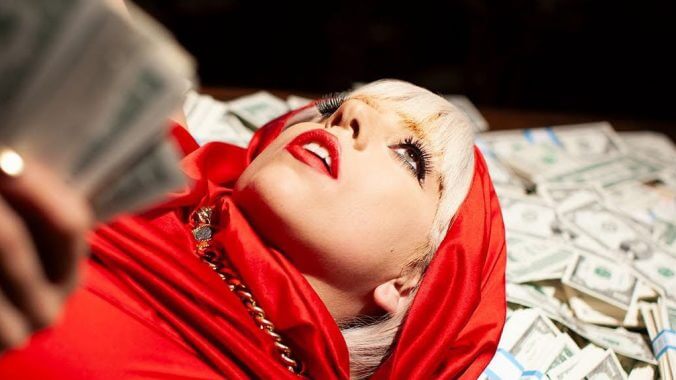The Fame at 15: Honoring Lady Gaga’s First and Most Luxurious Refuge

Lady Gaga fired off the incendiary tweet on the evening of October 24, 2019: “Fame is prison.” The tail end of the 2010s presented a puzzling—albeit wildly entertaining—time to follow the enigmatic pop star on social media. Around mid-2019, she began to dabble in trollish behavior, sporadically sprinkling her Twitter feed with baffling comments like “f” and the mirthless boomer inquiry “What’s fortnight.” (RIP to her broken promise “I’m calling my next album ADELE”). It was a weird time, even for a self-proclaimed mother to all outcasts. But her message on October 24 went beyond weird—it was a full-volume record scratch for pop culture. Lady Gaga practically invented modern fame. Who was she to forsake her own creation with the swipe of a finger across a keyboard?
Before graduating to a near-suffocating level of global superstardom, Lady Gaga was a devout scholar of celebrity, and her 2008 debut album The Fame was her 14-track dissertation. The album worshiped the tenets of fame with streamlined dance-pop and eccentric euphemisms, effectively aligning one of music history’s most powerful slew of consecutive pop singles: “Just Dance,” ”Poker Face,” “LoveGame” and “Paparazzi.” With over 300 weeks on the Billboard 200 and two diamond-certified singles, The Fame is the plinth of Gaga’s pop empire. Yet, despite its close study of stardom, the record ironically defies fame’s greatest rule of thumb; its 15 minutes of fame have lasted 15 years.
This month, on the anniversary of The Fame, we twirl a disco stick in honor of Lady Gaga’s nascent sparkle and revisit the fantastical refuge of her first LP, a headspace where the lights stay seductively low but the LED dancefloor never goes dark. In the confines of this metaphorical club, opulence and notoriety aren’t merely exhilarating pursuits—they’re a priority. Which is more than anyone could say about celebrity culture at the time of The Fame’s release. Or more accurately, tabloid culture.
The most authentic snapshot of celebrity in 2008 would actually consist of an entire gallery of snaps. Specifically, shots that are so notorious and widely distributed that they’re universally understood and require no caption. Think: a photo of Lindsay Lohan venturing into public with an alcohol monitor clipped to her ankle, or Britney Spears with the umbrella and the haircut. Put plainly, the unabashed bread and butter of publications like TMZ and PerezHilton.com and grocery store checkout line fodder.
With so much vulnerability in full view, it’s easy to grasp how fame became tantamount to shame in the mid-to-late 2000s. Embarrassment was inevitable, if not routine, thanks to a greedy domino effect that wore down the wills of countless A-listers. The more prominent a person was, the more paparazzi followed them in lockstep. More paps ensured more meltdowns. More meltdowns meant more bankable photos of a person’s worst moments, each captured in crisp detail. Bonus bucks if bodily fluids were involved, or if underwear wasn’t. Sex sold, sure. But disgust went viral. If a publication could repulse readers with stories about an “it girl” vomiting on herself, or catch her without the era’s signature whale tail under her skirt, it could also pander to their sense of smug superiority—usually expressed through bursts of profitable online shares.
In the media, mansion tours came second to bleary-eyed mugshots. Galleries depicting alleged drug use trumped hat-to-anklet breakdowns of designer outfits. Fame was a running joke, and the paparazzi worked overtime to cast its participants—especially young women—as the degenerate jesters. Every time a cultural figure stepped outside, they were hunted. But within The Fame, Lady Gaga decided they would be hallowed. Not just for their status, but for their shared craving for large-scale relevance and impact. As she once told MTV, “The Fame is not about who you are—it’s about how everybody wants to know who you are.’”
-

-

-

-

-

-

-

-

-

-

-

-

-

-

-

-

-

-

-

-

-

-

-

-

-

-

-

-

-

-

-

-

-

-

-

-

-

-

-

-








































